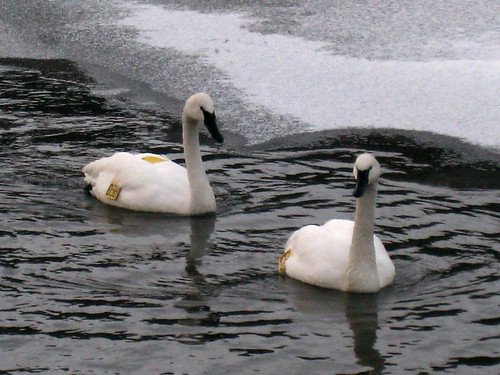
Young Trumpeter Swans Reintroduced into the Eastern US
Along with a blast of icy arctic air this week, we’ve been visited on my lake by a pair of Trumpeter Swans, which I photographed a couple of days ago a hundred yards or so down the shoreline from my house. Trumpeter Swans are the largest waterfowl native to North America – their wingspan can exceed eight feet – and they are also one of the rarest species of waterfowl in the world. These swans, which aren't wary of humans, were hunted for food and for their plumage nearly to extinction by the turn of the 20th century. Their flight feathers were considered to make the very finest quill pens.
More...
It's a big deal that this pair has made a temporary migration here, both for them and for us locally. It's the first recorded sighting ever of this species in our county. The story is all over our newspapers and TV news. Along with the return of bald eagles and osprey and heron and many other bird species to our region, the sighting represents a potent symbol of the natural environment healing itself with our assistance. I think it's especially cool that they're right here in my neighborhood. Yesterday Mary saw them even closer to our house, in the other direction up the shoreline. One of them, she said, hopped up onto the lake ice and gave itself an elaborate bath, exposing to all Pennsylvania its freaky-looking little black legs and enormous black feet.
Of course it's an even bigger deal for the swans, that they're reclaiming habitat and resuming ancient migrations. This is the first time in literally centuries that they’ve returned to a little lake like this so far south in their former range. The last known Trumpeter in the eastern US was shot on Lake Erie in 1886. By the 1930's, there were fewer than a hundred of these birds in existence, all of them in Alaska and western Canada. Efforts to revive Trumpeter populations slowly built the numbers in their western range, including down into the western coastal US. Then in 1982, biologist Harry Lumsden successfully launched a program to reintroduce the species in Ontario. There are now 1,000 Trumpeters in Ontario and nearly 9,000 in the US, including a healthy and growing population in the Great Lakes region.
"My" pair of Trumpeter Swans, according to those yellow tags visible in the photos, are young birds that came down from southwestern Lake Ontario. According to Lumsden, who was pleased to hear of this migration, the pair might hang around here for a while – just as long as there's food and open water for them. I hope they do stay, and I hope they return in future years. They're a beautiful and inspiring symbol to have around.
Thursday, January 15, 2009
Trumpeter Swans
Subscribe to:
Comment Feed (RSS)
|